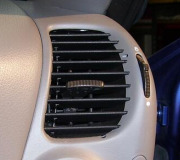Yes it is called the blower motor resistor (called the blower motor controller on schematics) most likely that is your problem but I'm sending you the diagnostics procedure just in case you need it
This guide cane help us fix it.
https://www.2carpros.com/articles/blower-fan-motor-works-on-high-speed-only
1999 Jeep Grand Cherokee 4.0L Eng Laredo
Vehicle Reference: HVAC SYSTEMS - AUTOMATIC
SYMPTOM DIAGNOSIS > BLOWER MOTOR INOPERATIVE
Possible causes: blower motor controller ground circuit open, Power Distribution Center (PDC) fuse No. 1 blown, defective blower motor. blower motor voltage supply circuit open/shorted to round, blower motor control circuit open/shorted to ground, blower motor controller defective, defective AZC module (no PWM signal), defective AZC module (PWM signal sent, blower high), blower motor control circuit shorted to blower motor ground circuit, or blower motor control circuit shorted to B+ (battery voltage).
Turn ignition off. Remove and inspect Power Distribution Center (PDC) fuse No. 1. If fuse is blown, replace fuse and check for a short circuit. If fuse is okay, go to next step.
Disconnect blower motor controller connector. Check connector and repair as necessary. Measure resistance between blower motor voltage supply circuit and ground. If resistance is less than 5 ohms, repair short circuit to ground. Calibrate HVAC system. See BODY VERIFICATION TEST VER-2A under PROGRAMMING. If resistance is greater than 5 ohms, go to next step.
Turn ignition off and disconnect blower motor. Using a known-good battery, apply voltage directly to blower motor. If blower motor runs properly, go to next step. If blower motor is inoperative, make sure blower motor is not obstructed. Repair or replace blower motor as necessary.
Disconnect blower motor controller. Check connector and repair as necessary. Measure resistance between ground and blower motor controller ground circuit. If resistance is less than 5 ohms, go to next step. If resistance is greater than 5 ohms, repair open ground circuit.
Turn ignition on (engine off). Ensure blower switch is off. Disconnect blower motor controller. Check connector and repair as necessary. Rotate mode selector switch to defrost position, turning front defroster on. Rotate blower switch to high (manual override). Check voltage at blower motor voltage supply circuit. If voltage is greater than 10.0 volts, go to next step. If voltage is less than 10.0 volts. repair open blower motor voltage supply circuit. Calibrate HVAC system. See BODY VERIFICATION TEST VER-2A under PROGRAMMING.
Turn ignition off and disconnect blower motor. Disconnect AZC module connector. Check connectors and repair as necessary. Measure resistance between blower motor control circuit and ground. If resistance is less than 5 ohms, repair short circuit to ground. Calibrate HVAC system. See BODY VERIFICATION TEST VER-2A under PROGRAMMING. If resistance is greater than 5 ohms, go to next step.
Disconnect blower motor controller connector. Disconnect AZC module connector. Check connectors and repair as necessary. Measure resistance of blower motor control circuit between blower motor controller and AZC module C2 connector. See WIRING DIAGRAMS . If resistance is greater than 5 ohms, repair open blower motor control circuit. If resistance is less than 5 ohms, go to next step.
Turn ignition off. Disconnect blower motor controller connector. Check connector and repair as necessary. Turn ignition on. Measure voltage between ground and blower motor control circuit at blower motor controller 3-pin connector. If voltage is greater than 0.5 volts, repair short to battery voltage in blower motor control circuit. Calibrate HVAC system. See BODY VERIFICATION TEST VER-2A under PROGRAMMING. If voltage is less than 0.5 volts, go to next step.
Turn ignition off. Disconnect blower motor controller connector. Disconnect Heater Ventilation A/C (HVAC) body harness connector (C202). Check connectors and repair as necessary. Measure resistance between blower motor control circuit and blower motor ground circuit. If resistance is less than 5 ohms, repair short to ground in blower motor control circuit. Calibrate HVAC system. See BODY VERIFICATION TEST VER-2A under PROGRAMMING. If resistance is greater than 5 ohms, go to next step.
Turn ignition on. Using DRB lab scope, select LIVE DAT, AUTO SET-UP, set the TIME DIVISION to 20MS/DIV. Set voltage range to RANGE±10.0 VOLTS. Backprobe blower motor control circuit at blower motor controller 3-pin connector with blower motor switch in LO (manual override) and mode select switch in defrost mode.
The voltage pattern should cycle from about 0.5 volts up to 5.0 volts in low speed fan position. If voltage pattern is cycling as specified, go to next step. If voltage pattern is not cycling as specified, replace defective AZC module.
With lab scope as in step 10) , backprobe blower motor control circuit at blower motor controller 3-pin connector with blower motor switch in HI (manual override) and mode select switch in defrost mode. The lab scope pattern should be flattened.
Now change the lab scope voltage setting to RANGE±2.0 VOLTS. The voltage pattern should cycle up to about 0.3 volts with blower motor in high fan speed. If voltage pattern is as specified, go to next step. If voltage pattern is not as specified, replace AZC module.
Disconnect blower motor. Check connector and repair as necessary. Turn ignition on. Place blower switch on HI and mode selector switch to defrost mode. Connect a test light across blower motor wiring harness 2-pin connector. If test light comes on brightly, test is complete. If test light does not come on brightly, replace blower motor controller.
Friday, February 20th, 2015 AT 8:48 AM





